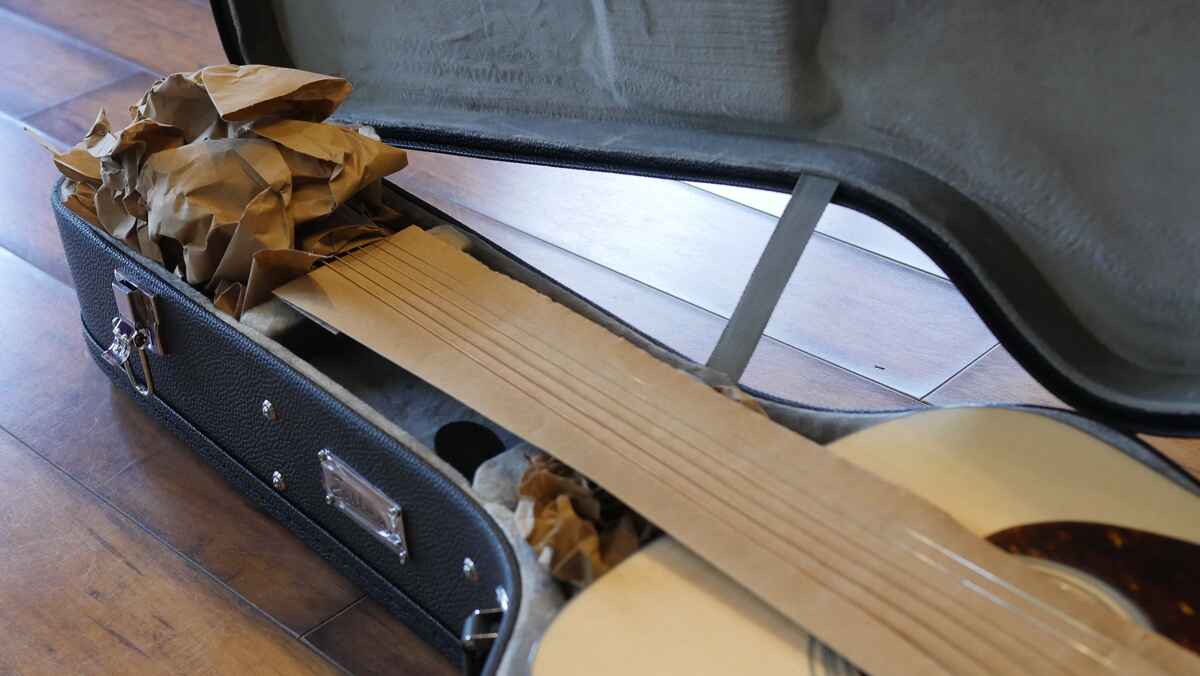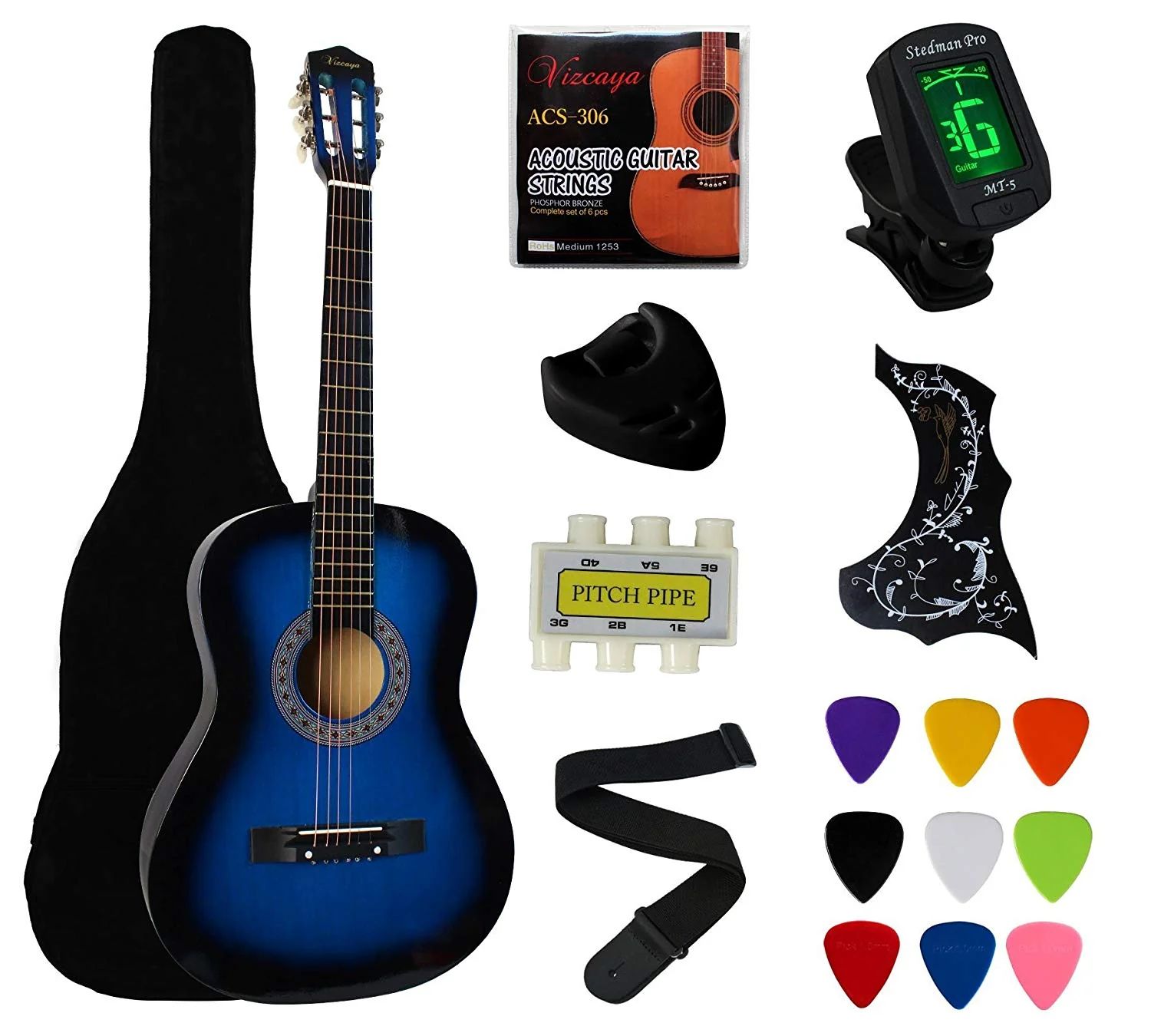Introduction
Shipping an acoustic guitar requires careful preparation and attention to detail to ensure it arrives safely at its destination. Whether you’re selling a guitar online or need to send it for repair, following the right steps will help protect your instrument from damage during transit. In this guide, we will walk you through the process of shipping an acoustic guitar, from gathering the necessary materials to tracking the shipment.
Shipping a delicate instrument like an acoustic guitar can be nerve-wracking, but with the right approach, you can ensure it reaches its intended location in pristine condition. By taking the time to properly pack and label the package, choosing the right shipping service, and insuring it against any unforeseen mishaps, you can have peace of mind throughout the shipping process.
While it may seem like a daunting task, shipping an acoustic guitar is a necessary skill to have for any guitar owner. Whether you’re a musician, guitar enthusiast, or someone looking to send a gift, understanding the proper techniques for shipping will not only protect your investment but also ensure that the recipient receives a guitar that is ready to play.
Follow the step-by-step instructions in this guide to learn how to ship an acoustic guitar safely and securely. By the end, you will have the confidence and knowledge to package your guitar properly, choose the best shipping option, and track the shipment until it reaches its final destination.
Step 1: Gather the Necessary Materials
Before you start packing your acoustic guitar for shipping, it’s important to gather all the necessary materials. Having everything you need at hand will help streamline the process and ensure that your guitar is adequately protected throughout its journey.
Here’s a list of the essential materials you’ll need:
- Sturdy Guitar Case: Choose a case that offers a high level of protection for your acoustic guitar. A hardshell case is recommended for maximum security.
- Packing Materials: You’ll need bubble wrap, foam padding, packing peanuts, or crumpled newspaper to cushion the guitar inside the case.
- Guitar Strap: Use a guitar strap to secure the guitar inside the case and prevent it from moving around during transit.
- Packing Tape: Use strong packing tape to seal the case and ensure it stays securely closed throughout the shipping process.
- Shipping Box: Choose a corrugated shipping box that is slightly larger than the guitar case to allow space for additional padding.
- Additional Protection: You may consider using corner protectors, polystyrene foam, or cardboard inserts to reinforce the box and provide extra cushioning.
- Shipping Labels: Have adhesive shipping labels ready to properly address the package and affix them securely to the box.
- Fragile Stickers: To alert handling personnel, use “Fragile” stickers or tape to indicate that the package contains delicate contents.
Having all these materials gathered before you start packing your acoustic guitar will make the process smoother and ensure that you don’t overlook any important items. It’s crucial to use high-quality materials that offer adequate protection to safeguard your guitar from any potential damage during transit.
Step 2: Prepare the Guitar
Before placing your acoustic guitar in its case for shipping, there are a few important steps you need to take to ensure its safety during transit. Properly preparing the guitar will help minimize the risk of any damage while it is being transported.
Here’s how to prepare your guitar for shipping:
- Remove Accessories: Take off any accessories such as capos, straps, or additional decorations from your guitar. Keeping them separate will reduce the risk of them scratching or damaging the guitar during transit.
- Loosen the Strings: Loosen the tension on your guitar strings to relieve the stress on the neck. This will help prevent any potential damage to the instrument while in transit.
- Pad the Guitar Neck: Place a soft cloth or bubble wrap around the neck of the guitar to protect it from any accidental bumps or impact.
- Secure the Moving Parts: If your guitar has any movable parts such as a tremolo arm or tuning pegs, secure them in place using painter’s tape or rubber bands to prevent them from moving during shipping.
- Protect the Body: Wrap the body of the guitar in a layer of bubble wrap or soft cloth to provide additional protection against any potential scratches or dings.
- Place Guitar in Case: Carefully place the prepared guitar into a well-padded, sturdy guitar case. Ensure that the guitar fits snugly inside the case and is secure.
By taking these steps to prepare your acoustic guitar, you’re significantly reducing the risk of damage during shipping. Properly securing and protecting the various parts of the guitar will help ensure that it arrives safely at its destination in the same condition as when it left.
Step 3: Pack the Guitar
Now that you have prepared your acoustic guitar, it’s time to pack it securely inside the guitar case. Proper packing will provide an additional layer of protection and help prevent any potential damage during transit.
Follow these steps to pack your guitar:
- Add Padding: Line the bottom of the guitar case with a layer of bubble wrap or foam padding to create a soft cushion for the guitar.
- Position the Guitar: Place the guitar inside the case, ensuring that it sits securely on the padding and is not pressed against the sides. The neck should be facing the neck rest, and the body should be centered.
- Add Padding Inside: Insert additional foam pads or bubble wrap around the guitar to fill any empty spaces and provide extra cushioning.
- Secure the Neck: Use a guitar strap or a cloth to secure the neck of the guitar to the neck rest or any designated holders inside the case. This will help stabilize the instrument and prevent it from moving around.
- Safeguard the Guitar Body: Place more padding or cushioning material on top of the guitar to protect the body. Ensure that it is securely positioned and doesn’t press down on the strings or bridge.
- Close the Case: Close and latch the guitar case, ensuring that it is securely fastened. Give it a gentle shake to make sure the guitar doesn’t move or shift inside the case.
Remember, the goal is to provide a snug and secure fit for the guitar inside the case. The padding and cushioning materials will help absorb any shocks or vibrations that may occur during shipping.
Keep in mind that the guitar should not move inside the case when it is closed and latched. If you hear any movement, open the case and readjust the positioning and padding accordingly.
By packing your guitar properly, you will greatly reduce the risk of any damage during transit and ensure that it arrives safely at its destination.
Step 4: Choose the Right Shipping Service
Choosing the right shipping service is crucial when it comes to sending your acoustic guitar. You want to ensure that your guitar is handled with care and arrives at its destination in a timely and secure manner.
Consider the following factors when selecting a shipping service for your guitar:
- Reputation and Reliability: Research different shipping companies and choose one with a good reputation for handling delicate items. Look for companies that specialize in musical instrument shipping or have experience in transporting fragile items.
- Insurance: Check if the shipping service offers insurance coverage for your guitar. It’s essential to have insurance that covers the full value of your instrument in case of any damage or loss during transit.
- Tracking and Shipping Updates: Find a shipping service that provides tracking options. This allows you to monitor the progress of your shipment and receive regular updates on its whereabouts.
- Shipping Cost: Compare shipping costs from different carriers and consider their pricing in relation to the level of service and insurance they provide. Keep in mind that it’s worth investing a bit more for a reputable and reliable shipping service.
- Delivery Timeframe: Consider the shipping service’s estimated delivery timeframe and ensure it aligns with your needs. If you have a specific deadline or time-sensitive situation, choose a service that offers guaranteed or expedited delivery options.
- Special Handling for Fragile Items: Inquire if the shipping service has specific protocols or procedures for handling fragile items like acoustic guitars. This can include using fragile stickers or employing extra caution during the handling process.
It’s important to carefully research and compare your shipping options before making a decision. Reach out to the shipping service directly if you have any specific questions or concerns regarding the transportation of your acoustic guitar.
By choosing the right shipping service, you can have peace of mind knowing that your guitar is in good hands and will be handled with the necessary care during the shipping process.
Step 5: Label the Package
Properly labeling your package is essential to ensure that your acoustic guitar is correctly identified and handled throughout the shipping process. Clear and accurate labeling will help prevent any confusion and minimize the risk of mishandling or misrouting.
Follow these guidelines when labeling your guitar shipment:
- Recipient’s Information: Clearly write or print the recipient’s name, address, and contact information on the shipping label. Double-check the accuracy of the information to avoid any delivery delays or misdeliveries.
- Your Return Address: Include your own return address on the shipping label. This ensures that the package can be returned to you if any issues arise during delivery.
- Special Handling Instructions: If there are any special instructions for handling the package, such as “Fragile” or “Handle with Care,” clearly indicate them on the label using appropriate stickers or annotations.
- Customs Information: If you’re shipping the guitar internationally, make sure to provide all the necessary customs information, including the value of the guitar and any required documentation.
- Barcodes and Tracking Numbers: If provided by the shipping service, affix any barcodes or tracking numbers provided to ensure accurate tracking and monitoring of the package’s progress.
It’s important to use legible and waterproof labels to ensure that the information remains intact and readable throughout the shipping process. Place the label on a flat, clean surface of the package that is visible and easily accessible.
Take a moment to review the label before affixing it to the package to ensure that all the information is correct and there are no errors or typos. This attention to detail will help streamline the shipping process and minimize the risk of any complications or delays.
By properly labeling your package, you provide the necessary information for the shipping service to handle your acoustic guitar appropriately and ensure its safe and accurate delivery.
Step 6: Insure the Package
Insuring your package is a vital step in ensuring the protection of your acoustic guitar during shipping. While you may have taken all the necessary precautions to pack and label the package properly, unforeseen circumstances or accidents can still occur. Having insurance coverage provides added peace of mind and financial protection in case of any damage, loss, or theft.
Here are a few things to consider when insuring your guitar shipment:
- Declare the Guitar’s Value: When purchasing insurance coverage, make sure to declare the accurate value of your acoustic guitar. This ensures that you’ll be adequately compensated in case of any damage or loss.
- Insurance Coverage Options: Check with the shipping service or your chosen insurance provider to understand the available coverage options. They may offer different levels of coverage that correspond to your guitar’s value.
- Documentation and Proof: Keep any receipts, photos, or documentation of the guitar’s value as evidence. In case of a claim, these can help expedite the insurance process.
- Package Inspection: Some insurance providers or shipping services may require a package inspection before accepting the insurance coverage. Cooperate and provide any necessary information to ensure your guitar is eligible for insurance.
- Insurance Fees: Consider the cost of insurance and factor it into your overall shipping budget. While it adds an additional expense, the peace of mind it provides is well worth the investment.
Before finalizing the insurance coverage, carefully review the terms and conditions, as well as any exclusions or limitations. Understand the process for filing a claim in case of any damage, loss, or theft and keep the insurance policy information easily accessible.
Insuring your package is a proactive measure that protects you against potential risks during shipping. It ensures that you are financially compensated in the event of any unfortunate incidents, providing you with added confidence throughout the transit process.
Step 7: Drop Off or Schedule a Pickup
Once you have prepared your acoustic guitar package and insured it, the next step is to determine how you will get it to the shipping carrier. You have two options: dropping off the package at a designated location or scheduling a pickup.
Consider the following factors when deciding whether to drop off or schedule a pickup:
- Convenience: Dropping off the package at a nearby shipping center may be more convenient if you have transportation readily available. On the other hand, scheduling a pickup can save you time and effort, especially if you have a busy schedule.
- Shipping Center Location: Check the locations and operating hours of the shipping centers near you. If there’s a center conveniently located, it may be a suitable option for dropping off the package. If not, scheduling a pickup can be more convenient.
- Package Size and Weight: Consider the size and weight of your guitar package. If it’s a large or heavy package, scheduling a pickup can be more practical, as it eliminates the need for you to carry and transport the package yourself.
- Shipping Service Provider: Different shipping service providers may have varying policies and options for drop-off or pickup. Research the options available from your chosen provider to determine which method best suits your needs.
- Tracking and Proof of Delivery: Both dropping off and scheduling a pickup should provide you with tracking information and a receipt, ensuring that you have proof of shipment and delivery.
When scheduling a pickup, make sure to provide all the necessary information to the shipping service, including your address, contact details, and any specific instructions regarding the pickup location, if applicable.
If you choose to drop off the package at the shipping center, ensure that it is securely sealed and properly labeled with the shipping label and any other necessary documentation.
Ultimately, the decision between dropping off or scheduling a pickup depends on your convenience, the package size, and your chosen shipping service’s policies. Evaluate your options and choose the method that best suits your needs and circumstances.
Step 8: Track the Shipment
Once your acoustic guitar package has been dropped off or picked up by the shipping service, it’s important to track its progress until it reaches its final destination. Tracking allows you to stay informed about the whereabouts of your package and provides you with peace of mind throughout the shipping process.
Here’s how to effectively track your guitar shipment:
- Obtain Tracking Information: If you haven’t already, make sure to obtain the tracking number for your package from the shipping service. This number is unique to your shipment and allows you to track its progress.
- Online Tracking: Use the tracking number to access the shipping service’s online tracking system. Enter the tracking number on their website or app to get real-time updates on the location and status of your package.
- Tracking Notifications: Opt-in to receive tracking notifications via email or SMS. This way, you’ll be alerted about any changes in the package’s status, including when it’s out for delivery or has been successfully delivered.
- Check Regularly: Make it a habit to check the tracking information regularly, especially if your package is traveling long distances or through multiple locations. Familiarize yourself with the expected delivery timeframe and monitor any potential delays or issues.
- Contact the Shipping Service: If you notice any unusual or concerning updates in the tracking information, don’t hesitate to reach out to the shipping service’s customer support. They can provide you with more detailed information and address any concerns you may have.
Tracking your guitar shipment allows you to anticipate its arrival and plan accordingly. It also gives you the ability to inform the recipient about the expected delivery date, ensuring they’re available to receive the package.
Remember to keep track of the tracking number and any related documents or receipts until the package has been safely delivered. This gives you a reference in case you need to follow up or file a claim with the shipping service.
By actively tracking your guitar shipment, you can stay informed and ensure a smooth and reliable delivery process for your beloved instrument.
Conclusion
Shipping an acoustic guitar may seem like a complex task, but by following the right steps and taking the necessary precautions, you can ensure that your instrument arrives safely at its destination. From gathering the necessary materials to tracking the shipment, each step plays an important role in safeguarding your guitar during transit.
By carefully preparing and packing the guitar, choosing the right shipping service, properly labeling the package, and insuring it, you can mitigate the risks associated with shipping a delicate instrument. Taking the time to follow these steps will give you peace of mind and protect your investment.
Remember, when shipping an acoustic guitar, attention to detail is key. Ensure that you have all the necessary supplies, prepare the guitar properly, and use high-quality packing materials. Choose a reputable and reliable shipping service that offers insurance coverage and tracking options. Label the package accurately and track its progress until it reaches its destination.
Shipping an acoustic guitar successfully requires knowledge, planning, and careful execution. By incorporating the guidelines outlined in this guide, you can confidently ship your acoustic guitar and ensure that it arrives safely and ready to be played.
Whether you’re selling it online, sending it for repair, or gifting it to someone, knowing how to properly ship an acoustic guitar is a valuable skill for any guitar owner or enthusiast. Take the time to learn and implement these steps, and you’ll be able to share your music with others while keeping your guitar protected and secure.

























